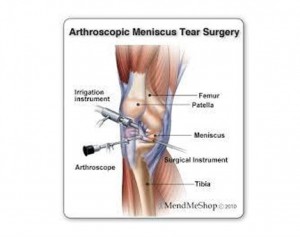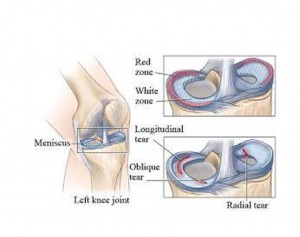Knee Arthroscopy with Meniscal Repair
Knee Arthroscopy with Meniscal Repair is an outpatient surgical procedure to repair torn knee cartilage. The torn meniscus is repaired by a variety of minimally invasive techniques and requires postoperative protection to allow healing. Physical therapy is useful to regain full function of the knee, which occurs on average 4-5 months after surgery.
Preparation for Knee Arthroscopy with Meniscal Repair
Preparations depend on your surgeon. In general, you should:
- Avoid certain medications. Your doctor may want you to avoid taking medications or dietary supplements that can increase your risk of bleeding.
- Fast beforehand. Depending on the type of anesthesia you’ll have, your doctor may want you to avoid eating, or drinking six to twelve hours before your procedure.
- Arrange for a ride. You won’t be allowed to drive yourself home after the procedure, so make sure someone will be available to pick you up. If you live alone, ask someone to check on you that evening or, ideally, stay with you the rest of the day.
- Choose loose clothing. Wear loose, comfortable clothing baggy gym shorts, slip on shoes for example, if you’re having knee arthroscopy so you can dress easily after the procedure.
Knee Arthroscopy with Meniscal Repair Recovery
Medications: Anti-inflammatory medications, taken by mouth or injected directly into the knee, can be useful to reduce the pain and swelling symptoms associated with meniscus tears, but do not improve healing.
Exercises and Physical therapy: Quadriceps strengthening exercises are useful to reduce swelling and restore normal muscular control to an injured knee. It’s useful to reduce symptoms and speed rehabilitation.
Risks for Knee Arthroscopy with Meniscal Repair
As with any surgical procedure, complications can occur. Some possible complications may include, but are not limited to, the following:
- Bleeding into the knee joint.
- Damage to the cartilage, meniscus, or ligaments in the knee.
- Formation of a blood clot in the leg.
- Injury to a blood vessel or nerve.
- Infection in the knee joint.
- Knee stiffness following the procedure.
- Compartment syndrome.
The Meniscus repair is a safe procedure with a complication rate of 1.3%. The most common complications are injuries to skin nerves, the vast majority of which resolve without additional procedures by three months post surgery. Injury to larger nerves or blood vessels is rare, as are blood clots. Knee stiffness, infections, and other problems are uncommon, but can occur. An experienced surgical team uses special techniques to minimize these risks, but unfortunately they cannot be completely eliminated.
Managing risk: The most effective treatment of complications is prevention. For example, the risk of infection is decreased by giving antibiotics prior to surgery, and the risk of blood clots is decreased by using anti-embolism stockings. If infection does occur, repeat arthroscopy to remove infected tissue and debris, in conjunction with antibiotics for six weeks is generally effective. If blood clots occur, blood thinners are used for three months to decrease the chance of clots growing or breaking off and traveling to the lungs. Knee stiffness can often be managed with physical therapy and braces, but may require arthroscopic releases to restore motion. Since most complications can be effectively managed when identified promptly, if patients have questions or concerns about the post-operative course, the surgeon should be informed as soon as possible.


